Nutrition > Solutions Guide > NUR 2392 MDC2 Exam 1 Study Guide; possible test questions: seizure precautions; Latest. (All)
NUR 2392 MDC2 Exam 1 Study Guide; possible test questions: seizure precautions; Latest.
Document Content and Description Below
NUR 2392 MDC2 Exam 1 Study Guide; possible test questions: seizure precautions; Latest. 1 MDC II: Exam 1 **possible test questions: seizure precautions 1. Risk factors to educate pts. about ca... ncer ● Smoking ● Poor nutrition ● Excess weight ● Sedentary lifestyle ● Exposure to environmental carcinogens such as sunlight; pollutants in the air, soil, water, or food; or medical treatments such as medications or radiation ● Genetics ● Educate about prevention methods (smoking cessation, sunscreen, ear plugs, sunglasses) ● Educate about annual screenings ***Patients with family history of cancer want to focus on PRIMARY PREVENTION (reduce risk for cancer development: healthy dietary habits [[avoid eating: excess animal fat, nitriteslunch meats, minimize intake of red meat & alcohol consumption, eat more bran and veggies(broccoli, cauliflower, brussel sprouts, and cabbage), eat more foods high in Vit. A (apricots, carrots, leafy greens) and in Vit C (citrus fruits, etc.)]] vaccinations, sunscreen, smoking cessation, exercise, etc) and inquire about Genetic Testing**** 2. Radiation – How it works, terms related to it, Pt. Education, side effects ● Kill or reduce tumor size, relieve obstruction or decrease tumor size by rapidly dividing the cell ○ May be given before chemo to shrink tumor ○ Area is marked by a semi permanent tattoo ○ Tx 15-30 min 5 days a week for 2-7 weeks ● Exposure to radiation influences cancer growth ● Environmental factors that affect growth ○ UV, Sun, X-ray, Radioactive chemicals ● External Radiation ○ Local treatment ; high energy rays to the tumor via linear accelerator ● Brachytherapy(internal radiation) ■ Short and Long Term ○ Implanted into affected or body cavity by implanted seeds/ rods ○ Used commonly with cervical , prostate, breast skin cancer ● Radiopharmaceuticals ○ Given IV or PO E.G., Bone and Thyroid cancer ● Radiation can also be used in adjunction with surgery - kills cells left behind to reduce recurrence and improve survival 3. Malignant: Abnormal cells, serve no useful function, and are harmful to normal body tissues; indicates cancer; it has migrated or metastasized, and is serious and can lead to death withoutintervention; rate of growth varies- usually rapid; rarely contained within a capsule; immobile & irregular when palpated vs. Benign: Normal cells growing in the wrong place or at the wrong time, as a result of a problem with cellular regulation (process that controls cellular growth, replication and differentiation); (harmless; does not usually require intervention; slow, steady growth; remains localized; usually contained within a capsule; moveable) Metastasize: The ability to spread; cancer cells separates from the original tumor, spread to new areas, and establish new cancers at distant sites (unique to cancer cells, and is a major cause of death); occurs when cancer cells move from primary location to other remote colonies 4. How do we reduce the risk for infection? (Not sharing utensils/toothbrushes, avoiding crowds/sick people, hand washing) ○ Monitor Lab values ○ Adhere to standard precautions to include strict hand hygiene ○ Monitor for S/S of infection-fever, chills, cough, sore throat, nasal congestion, diarrhea, vomiting ○ Implement neutropenic precautions: i. Stay clean (wash hands and shower daily) ii. Ask others to wash their hands iii. Have safe sex iv. Avoid sick people and recently vaccinated people v. Stay away from large crowds ○ Patient and family education regarding development of infection and precautions to take to prevent infections 5. Electrolyte Levels (K+, Ca, Na, Mg) – Identify high/low Sodium (Na) - 136-145 mEq/L - Where sodium goes, water follows - Function = acid base balance, nerve impulses Elevated Hypernatremia (greater than 145 mEq/L) ● Dehydration ● Decreased water intake ● Excessive water loss ● Diabetes Insipidus ● Kidney disease/ failure ● Hypercortisolism ● Cushing syndrome ● NPO ● Fever ● Watery Diarrhea ● Excessive diaphoresis ● Excessive administration of IV fluids containing sodium ● Hyperaldosteronism ● Corticosteroids Lab Findings- Serum sodium - increased - Serum osmolality - increased - Urine sodium - decreased Signs and Symptoms (hypernatremia) ● Thirst ● Fever ● Dry mucous membranes ● Hypotension ● Tachycardia ● Low jugular venous pressure ● Restlessness Nursing Interventions hypernatremia - Antiembolism Stockings – to prevent deep vein thrombosis - Restrict sodium intake Low Hyponatremia (less than 136 mEq/L) ● Excessive diaphoresis ● Diuretics ● Wound drainage ● NPO ● Low salt diet ● Hyperglycemia ● Fluid overload/ excessive water intake ● Fluid volume depletion ● Syndrome of inappropriate antidiuretic hormone secretion (SIADH) ● Increase in antidiuretic hormone ● Kidney failure ● Heart failure ● Liver disease ● Adrenal insufficiency Lab Findings - Urine specific gravity - Increased - Serum sodium - decreased - Serum osmolality - decreased - Blood Urea nitrogen - decreased - Urine sodium - decreased Signs and symptoms (hyponatremia) ● Lethargy ● Headache ● Confusion ● Apprehension ● Seizures ● Coma Nursing interventions - access neurologic status – assess for changes from baseline - implement seizure precautions Potassium (K) - 3.5-5.0 mEq/L - Some control over intracellular osmolarity and volume - Regulate protein synthesis, glucose use and storage - NEVER IV push (Lethal!) - Always given via administration of IV infusion pump - Functions = cellular integrity - neuromuscular transmission - acid base balanceformation of proteins - conversion of carbohydratesElevated Hyperkalemia (greater than 5.0 mEq/L) ● Causes ○ Salt substitutes ○ Potassium chloride ○ Tissue damage ○ Acidosis ○ Uncontrolled diabetes ○ Transfusions of PRBC ○ Kidney failure ○ Potassium sparing diuretics ○ ACE inhibitors, steroids, diuretics, potassium supplements ○ Burns ○ Trauma ○ Rhabdomyolysis ○ Metabolic Acidosis ○ Ketoacidosis Lab Findings - Arterial Blood Gas - decreased pH - Serum potassium - increased - Hemoglobin - decreased - Hematocrit - decreased - Creatine kinase level - increased - Potassium Level (urine) decreased Signs and symptoms (Hyperkalemia) - Muscle twitches, cramps, paresthesia - Irritability and anxiety - Decreased BP - EKG changes - Dysrhythmias - Irregular Rhythm - Abdominal cramping - Diarrhea Nursing interventions hyperkalemia - - monitor cardiac rhythm for rhythm changes - - assess respiratory and cardiac status for respiratory or cardiac decline - - Monitor Oxygenation to maintain oxygenation - -Monitor arterial blood gas to monitor oxygenation and ventilation - - restrict potassium intake - Treatment - - IV diuretics - - IV calcium chloride - -IV insulin - - Correct acidosis - - Continuous cardiac monitoring - - Monitor electrolytes - - Hemodialysis/ peritoneal dialysis Low Hypokalemia (less than 3.5 mEq/L) ● Causes ○ Diuretic therapy ○ Digitalis like drugs (digoxin) ○ Corticosteroids ○ Diarrhea ○ Vomiting ○ Wound drainage ○ Prolonged NG suction ○ NOP ○ Hyperinsulinism ○ TPN ○ Water intoxication ○ Alkalosis○ Fluid overload ○ Insulin administration ○ Hyperaldosteronism (disorder in which the adrenal gland releases too much of the hormone aldosterone into the blood.) ○ Diabetic Ketoacidosis ○ Acute Kidney Failure ○ Medications (diuretics, beta blockers, laxatives) ○ Magnesium defciency ○ Cushing’s Syndrome Lab fndings - Serum potassium - decreased - Arterial blood gas - increased ph and bicarbonate - Potassium level (urine) - decreased - Glucose - increased - Magnesium level - decreased Signs and symptoms Hypokalemia - Alkalosis - Shallow respirations - Irritability - Confusion, drowsiness - Weakness, fatigue - Arrhythmias - Irregular rate, Tachycardia - Lethargy - Thready pulse - Decreased intestinal motility - Nausea - Vomiting - Ileus - Nursing interventions hypokalemia - monitor vital signs for changes in blood pressure and HR - - Monitor intake and output - -Monitor cardiac rhythm for changes Treatment - - Administer replacement - - determine underlying cause and treat - - discontinue or reduce dose of diuretics - - monitor electrolytes - - continue cardiac monitoring Phosphorus -( 3.0 to 4.5 mg/dL) - found in bones - activates vitamins & enzymes; assists in cell growth & metabolism, → Calcium-Phosphorus Relationship - Increased calcium = decreased phosphorus Calcium (Ca) - 9.0 to 10.5mg/dL - Absorption requires active form of Vitamin D - Stored in bones - Blood levels regulated by parathyroid hormone - Thyrocalcitonin (aka calcitonin): hormone secreted by thyroid - lowers blood calcium - Functions = blood clotting - cellular membrane stability Elevated Hypercalcemia (greater than 10.5 mg/dL) ● Excessive oral intake of vitamin D ● Excessive intake of calcium ● Kidney failure ● Malignancy ● Immobility ● dehydration ● Addison's disease ● Paget’s Disease● Hyperthyroidism ● Sarcoidosis ● Hyperparathyroidism ● Medications (lithium, tamoxifen, thiazide diuretics) Lab fndings - Serum calcium - increased - Calcium level (ionized) - increased - Albumin - decreased - Parathyroid hormone test - increased Signs and symptoms (hypercalcemia) - Increased HR and BP (in beginning,) prolonged hypercalcemia decreased HR - Poor perfusion - cyanosis & pallor, (blood clots are more likely in lower legs - Neuromuscular changes - severe muscle weakness, decreased deep tendon reflexes without paresthesia - Confused - Lethargic - GI changes, decreased peristalsis (nausea, vomiting, constipation, abdominal distention) Hypercalcemia Nursing care - monitor vital signs for changes in blood pressure and HR - monitor cardiac rhythm for rhythm changes - Assess neuro, GI, renal, and cardiac status for decline Treatment - Administer IV fluids - Administer medications ( diuretics, corticosteroids) -avoid overload - continuous cardiac monitoring - maintain safety to avoid fractures - monitor electrolytes Low Hypocalcemia (less than 9.0mh/dL) ● Causes ○ Steatorrhea ○ Wound drainage ○ Vit. D defciency ○ Lactose intolerance ○ Crohn's Disease ○ Hypothyroidism ○ Hypoparathyroidism ○ End stage kidney disease ○ Renal Failure ○ Liver disease ○ Sepsis ○ Pancreatitis ○ Magnesium defciency ○ Hyperphosphatemia - Excessive intake of phosphorus containing foods and drinks Lab fndings - Serum calcium - decreased - Calcium level (ionized) - decreased - Phosphate level - increased or decreased - Magnesium level - decreased - Parathyroid hormone test - low to normalSigns and symptoms (hypocalcemia) - Trousseau’s Sign - Chvostek’s Sign - Decreased bone density - Muscle spasms - Tetany - Increased DTR - ECG changes - decreased myocardial function - Increased risk for developing abnormal rhythms ! seizure precautions b/c of nerve excitability Hypocalcemia Nursing care - monitor vitals – BP & HR - monitor In and out - monitor cardiac rhythm for rhythm changes - assess neuro, renal and cardiac status for decline - maintain IV - nutrition screening to determine nutritional intake - safety, educate, administer medication Treatment - Administer Iv fluids - Administer replacement - Continuous cardiac monitoring - Seizure precautions - Monitor electrolytes Magnesium (Mg) 1.8 to 2.6 mEq - Critical for skeletal muscle contraction, carbohydrate metabolism, ATP formation, vitamin activation, cell growth - Functions = Neuromuscular interactions - cardiac contractility Elevated Hypermagnesemia (greater than 2.6 mEq/L) ● Causes ○ Increased magnesium intake ○ Magnesium containing antacids and laxatives ○ IV Magnesium replacement ○ Dehydration ○ Addison’s Disease ○ Hyperparathyroidism ○ Hyperthyroidism ○ Kidney disease/ failure (decreased excretion of magnesium resulting from kidney disease) ○ Acidosis ○ Adrenal insufciency Lab Findings - Serum Magnesium - increased - Serum potassium increased - Serum calcium - decreased - Creatinine Clearance - decreased - Arterial blood gas - increased carbon dioxide, decreased pH Signs and symptoms (hypermagnesemia) - Flushing - Decreased DTR’s (deep tendon reflexes) - Muscle weakness - Lethargy - Decreased respirations - Bradycardia- Hypotension Hypermagnesemia Nursing Care -- monitor vitals – BP & HR - monitor In and out - monitor cardiac rhythm for rhythm changes - assess neuro, renal and cardiac status for decline - maintain IV - nutrition screening to determine nutritional intake - safety, educate, administer medication Treatment - administer Iv fluids - Continuous cardiac monitoring - Seizure precautions - Monitor electrolytes - Correct acidosis - Hemodialysis Low Hypomagnesemia (less than 1.8 mEq/L) ● Causes ○ Irritable Bowel Syndrome ○ Ethanol ingestion (Alcoholism ) ○ Hypoparathyroidism ○ Malnutrition ○ Starvation ○ Diarrhea ○ Steatorrhea ○ Celiac Disease ○ Crohn's disease ○ Kidney disease ○ Pancreatitis ○ Ketoacidosis ○ Citrate ○ Medications (diuretics, digoxin, cisplatin, cyclosporine) Lab Findings - Serum Magnesium decreased - Serum potassium decreased - Serum calcium decreased Signs and symptoms (Hypomagnesemia) - Confusion - Increased DTRs - Neuromuscular irritability - Seizures - Muscle cramps - Tremors - Insomnia - Tachycardia Hypomagnesemia Nursing care -- monitor vitals – BP & HR - monitor In and out - monitor cardiac rhythm for rhythm changes - assess neuro, renal and cardiac status for decline - maintain IV - nutrition screening to determine nutritional intake - safety, educate, administer medication Treatment - administer IV fluids- Continuous cardiac monitoring - Seizure precautions - Monitor electrolytes - administer replacement Chloride (98 to 106 mEq/L) - imbalance occurs as a result of other electrolyte imbalances. Treat underlying electrolyte imbalance ot acid-base problem * from ppt notes - electrolyte considerations for older adults 1. Are at risk for most electrolyte imbalances from age related organ changes. 2. Have less total body water than younger adults; more at risk for fluid imbalances; more likely to be taking drugs affecting fluid or electrolyte balance 6. Difference between palliative care/hospice Palliative care - Supports from time of diagnosis through treatment plan - Supports whole person, not just disease - Focuses on psychological, social and spiritual issues - Provides support system during the entire disease process - Goal - prevent and treat symptoms and side effects of treatment asap - Improve quality of life Hospice Care (end-of-life) care - Care for patients with incurable disease where tx is no longer an option for a possible cure- Goal - Improve quality of life at end of days - Supportive care to help relieve symptoms of cancer - Support system for family and patient, emotional and spiritual - Therapy, counseling, financial and emotional support (even after death), funeral planning - Educate on signs & symptoms of end of life - Nursing care for end of life - Promotion of comfort - Turning and repositioning - Administration pain medication as prescribed - Keeping clean and dry, as well as oral care as needed - Emotional support to family 7. Chemotherapy precautions (When patient comes home with chemo: Washing hands, Gloves for meds or cleaning up spills, condoms/barrier for sex, flush twice, wash clothes separate) ○ Nutrition and hydration: Ensure the patient maintains adequate intake. Consult the dietician to assess nutritional and cultural needs. Administer antiemetics as prescribed. ○ Pain control: Ensure adequate pain control by assessing patient level of pain frequency and administering the prescribed medications. ○ Assure adequate rest: fatigue is a common side effect of chemotherapy; be sure the patient has adequate rest periods by grouping periods of activities to allow more time for rest. Avoid sudden movements. ○ Skin care: perform frequent skin assessment and implement measures to maintain and manage skin breakdown. ○ Emotional support: Provide emotional and spiritual support to the pt and family by providing education ○ Chemotherapy precautions: Adhere to strict precautions while handling blood or bodily fluids to protect the pts, families, and staff. i. Vomit into a plastic bucket, do not use it for anything else, and throw it out after your final chemo session ii. Wear disposable gloves when handling soiled clothing or bedsheets. ○ Monitor for side effects 8. Nursing Dx for Fluid overload, Dehydration, Imbalance (Lab packet in email – NANDA Nursing Dx) ○ Fluid overload i. May be related to: 1. Excess fluid or sodium intake 2. Compromised regulatory mechanism ii. Possibly evidenced by 1. Ascites. 2. Aphasia, muscle twitching, tremors, seizures.3. Bounding pulses. 4. Changes in the level of consciousness 5. Crackles. 6. Distended neck and peripheral veins. 7. Edema 8. Elevated central venous pressure. 9. Extra heart sounds S3. 10. Hypertension. 11. Productive cough. 12. Shortness of breath. 13. Sudden weight gain 14. Tachypnea with or without dyspnea, orthopnea. 15. Tachycardia iii. At risk for: 1. Pericarditis 2. Heart failure 3. Delayed wound healing 4. Tissue breakdown 5. Decreased bowel function ○ Dehydration i. May be related to 1. Active fluid loss (burns, diarrhea, fistulas, gastric intubation, hemorrhage, wounds, etc.) 2. Regulatory failure (diabetes insipidus, diabetic ketoacidosis, adrenal disease, systemic infections, recovery phase of acute renal failure, etc.) ii. Possibly evidence by 1. Abdominal distention. 2. Confusion, restlessness. 3. Dark concentrated urine. 4. Decreased urine volume. 5. Decreased central venous pressure. 6. Flattened neck veins. 7. Hypotension. 8. Pale, moist, clammy skin. 9. Tachycardia. 10. Tachypnea. 11. Weak pulses. iii. At risk for: 1. Heat injury (heat cramps, heat exhaustion, heat stroke) 2. Urinary and kidney problems (UTI, kidney stones, kidney failure) 3. Seizures 4. Hypovolemic shock ○ Hyperkalemia (K+ > 5)i. May be related to: 1. Renal disease 2. Treatment-related side effects such as cytotoxic drugs, NSAIDs, diuretics, potassium-containing medications, massive transfusion with banked blood ii. At risk for: 1. Heart arrhythmias 2. Decrease in kidney function 3. Heart failure ○ Hypokalemia (K+<3.5) i. May be related to: 1. Diarrhea, vomiting 2. Diabetic acidosis, renal failure 3. High-sodium diet, starvation 4. Profuse sweating 5. Tx related side-effects (diuretics, Total parenteral nutrition, etc.) ii. At risk for: 1. Bradycardia 2. Arrhythmias 3. Cardiovascular collapse 4. Acute respiratory failure 5. Muscle paralysis ○ Hypernatremia (Na > 145) i. May be related to: 1. diarrhea , vomiting 2. Diabetes insipidus, renal disease 3. Fever, profuse sweating 4. high-protein diet 5. Side effects of medication such as osmotic diuretics ii. At risk for: 1. Brain hemorrhage 2. Death 3. Cerebral edema ○ Hyponatremia (Na < 135) i. May be related to 1. Diarrhea, vomiting 2. Renal dysfunction 3. Tx-related side effect (medications, gastric suctioning, electrolytefree intravenous solutions) 4. Water intoxication ii. At risk for 1. Cerebral edema 2. Brain disease 3. Herniation of the brain4. Cardiopulmonary arrest 5. Seizure 6. Coma 7. Death ○ Hypermagnesemia (Mg > 2.1) i. May be related to 1. Chronic diarrhea 2. Diabetic ketoacidosis 3. Renal dysfunction 4. Tx-related side effects (medications containing magnesium, dialysis with hard water, diuretic abuse) ii. At risk for 1. Cardiovascular complications (hypotension, arrhythmias, etc.) 2. Neurological disorders (confusion, lethargy, etc.) 3. Cardiorespiratory arrest 4. coma ○ Hypomagnesemia (Mg < 1.3) i. May be related to 1. Diabetic ketoacidosis, hyperaldosteronism. 2. Excessive losses 3. Malnutrition 4. Renal disease 5. Tx-related side effects of medications (antifungals, aminoglycosides, chemotherapy agents, diuretics) ii. At risk for 1. Disturbances in every organ system 2. Fatal complications (ventricular arrhythmia, coronary artery vasospasm, sudden death) ○ Hypercalcemia (Ca > 10.5) i. May be related to 1. Hyperparathyroidism 2. Hyperthyroidism 3. Renal disease 4. Tx-related side effects of medications (anticancer drugs, theophylline, lithium, thiazide diuretics) ii. At risk for 1. Osteoporosis (bone fracture, spinal curvature, loss of height) 2. Kidney stones 3. Kidney failure 4. Nervous system problems (confusion, dementia, coma) 5. arrhythmia ○ Hypocalcemia (Ca < 8.5) i. May be related to 1. Chronic laxative abuse2. Diarrhea 3. Renal failure 4. Tx-related side effects of medications (antibiotics, anticonvulsants, corticosteroids, diuretics) ii. At risk for 1. Death 2. Seizures 3. Tetany 4. refractory hypotension 5. arrhythmias 9. Tumor Lysis Syndrome (*Read Textbook) TLS = large numbers of tumor cells are destroyed rapidly - Intracellular contents (potassium and purines) released faster than body can eliminate - Is a positive sign that cancer treatment is working - Seen commonly in acute leukemia, high grade lymphomas, small cell lung cancer, germ cell tumors, inflammatory breast cancer, melanoma, and multiple myeloma & older adults undergoing cancer tx - Sever or untreated = tissue damage, acute kidney injury, and death - Serum potassium can increase to hyperkalemia causing cardiac dysfunction - Purines form uric acid causing hyperuricemia = block kidney tubules = AKI - Sudden hyperkalemia, hyperuricemia and hyperphosphatemia = life threating effects on heart muscle, kidneys, and CNS - Early signs - Lethargy, - Nausea - Vomiting - Anorexia - Flank pain - Muscle weakness - Cramp - Seizures - Edema - Altered mental status - Prevention = hydration (dilutes serum potassium levels)- 3000ml (5000ml idea) per day. ! day prior to tx, day of tx and 3 days after tx - Prophylaxis is essential for high risk patients receiving cancer therapy that is expected to reduce tumor burden quickly - Monitor - daily weight - Serum electrolyte values- Treatment - Fluids - Diuretics - increase urine flow through kidney (used cautiously) From book - Management becomes more aggressive for patients who become hyperkalemic or hyperuricemic. - In addition to fluids, diuretics (especially osmotic types) are given to increase urine flow through the kidney. - These agents are used cautiously to avoid dehydration. - Drugs that promote purine excretion, such as allopurinol (Aloprim, Zyloprim), rasburicase (Elitek), or febuxostat (Uloric) are given. -To reduce serum potassium levels for mild-to-moderate hyperkalemia, sodium polystyrene sulfonate can be given orally or as a retention enema. -For more severe hyperkalemia IV infusions containing glucose and insulin may be given. -Patients who have severe hyperkalemia and hyperuricemia may need dialysis and intensive care. 10. Superior Vena Cava Syndrome (*Read Textbook). Due to the compression of the SVC walls by a tumor that prevents the venous return of the blood to the heart. It is associated with lung cancer, metastatic mediastinal tumors, lymphoma, breast cancer, and indwelling venous catheters. S/S: swelling of the face and neck, swelling of the arms, dysphagia, cough. More apparent when pt is in a supine position Dx: imaging w/ CT or MRI Treatment: radiation, chemotherapy Nursing care/interventions: assessment of respiratory and cardiac systems, maintain patent airway, monitor oxygenation, monitor labs, provide emotional and spiritual support to the pt and family 11. Malignant Pericardial Effusion (*Read Textbook) This develops due to fluid accumulation around the pericardial sac > compression of the heart > cardiac tamponade (life-threatening emergency). MPE is associated with metastatic lung cancer, breast cancer, melanoma, leukemia, lymphoma and chemotherapy to the chest wall. S/S/: dyspnea, fatigue, distended neck veins, distant heart sounds, tachycardia, orthopnea, narrow pulse pressure, pulsus paradoxusTx: radiation, surgical intervention Nursing care/interventions: assessment for neurological deficits, manage pain, administer medications as prescribed, prevent skin breakdown, provide emotional & spiritual support to the pt and family. 12. Oncological Emergencies: Hematologic, structural, metabolic Metabolic: Hypercalcemia, Tumor lysis syndrome, SIADH Hematologic: Febrile Neutropenia, Hyperviscosity syndrome Structural: Superior Vena Cava Syndrome, Malignant Pericardial Effusion, Spinal cord compression 13. Prophylactic/Curative/Palliative Prophylactic: medicine or course of action used to prevent disease (i.e. prophylactic double mastectomy to prevent getting breast cancer, prophylactic antibiotics to avoid getting infection) Curative Care: Health care practices that treat patients with the intent of curing them, not just reducing their pain or stress. Cure a disease. “Medicine/Remedy” (i.e. Chemotherapy, which seeks to cure cancer; Antibiotics for bacterial infections; Cast for a broken limb) Palliative: (of a medicine or medical care) Relieving pain without dealing with the cause of the condition. “Relief, but not cure”. Palliative care can begin at diagnosis at same time as treatment. Improves quality of life, decreases pain, increases comfort. 14. Potassium administration – IV Pump, never bolus 15. CAUTION mnemonic (Common S/S that could indicate cancer) Warning signs of CA Change bladder/bowel habits A sore that does not healUnusual bleeding or discharge, any body orifice Thickening or presence of lump Ingestion or difficulty swallowing Obvious change in wart or mole (color, size, texture) Nagging cough or hoarseness that is prolonged White patches in the mouth or tongue 16. Hypomagnesemia Pt – probably alcoholic 17. Understand Diuretics (Lasix, Bumex (?), Hydrochlorothiazide/HCTZ), which are which, and what they dump from the body (Laisha) Pg 175 & 177 Lasix and Bumex are both loop diuretics that help promote fluid loss and can also affect blood pressure. Pt wants to eat food high in K+ because these loop diuretics will deplete K+, Mg, and Na. HCTZ is a thiazide medication that Unlike loop diuretics, the action of thiazides is selflimiting (i.e., diuresis decreases after edema fluid is lost). Therefore the dehydration that may occur with loop diuretics is not common with these drugs. Patients also prefer thiazides because of the gradual onset of diuresis. Pg699 18. Pt at increased risk of infection during cancer treatment and how to decrease Handwashing, No fresh fruits, No crowds, Don’t go around sick people. 19. Primary, Secondary, Tertiary ways of cancer prevention Primary Prevention - trying to prevent yourself from getting a disease (ie sunscreen, smoking cessation, healthy lifestyle, etc). Secondary Prevention - trying to detect a disease early and prevent it from getting worse (ie screening for cancer before the appearance of signs or symptoms). Tertiary Prevention - trying to improve your quality of life and reduce the symptoms of a disease you already have. ○ Primary: i. Use of sunscreen ii. Eliminate the use of tobacco iii. Utilize personal protective equipment in the workplace iv. Reduce alcohol consumption v. Modify dietvi. Limit sex partners/practice safe sex vii. Removal of at-risk tissues viii. Chemoprevention ix. Vaccinations ○ Secondary: i. Routine screenings 20. Staging of Cancer Chart (Pg. 378): Once the tumor is classified as malignant, it is staged and graded. Staging: Describes the extent of spread of the tumor within the body from the site of origin Grading: The degree of malignancy or cell differentiation of the tumor cells Primary Tumor (T) Tx Primary tumor cannot be assessed T0 No evidence of primary tumor Tis Carcinoma in situ T1, T2, T3, T4 Increasing size and/or local extent of the primary tumor Regional Lymph Nodes (N) Nx Regional lymph nodes cannot be assessed N0 No regional lymph node metastasis N1, N2, N3 Increasing involvement of regional lymph nodes Distant Metastasis (M) Mx Presence of distant metastasis cannot be assessed M0 No distant metastasis M1 Distant metastasis21. Sweating a lot – risk for hyponatremia 22. Multidisciplinary Care Team – develop a plan, talk w/ fam (Slide in PPT) 23. Infection – CBC w/ differential. Differential shows different types of WBCs 24. Chemo wipes out neutrophils, kills them. 25. Neutropenic Precautions – If patient has no neutrophils to protect them from infection, they are on neutropenic precautions. “I’m protecting THEM from ME” (Reverse Isolation) 26. Cancer patient has LOW (or zero) neutrophils: High risk for infection 27. Segmented seniors – Needed to fight infection! 28. Baby bands – Not mature enough to fight infection. “Shift to the left” – Baby neutrophils 29. Patient Education for surgical procedure for cancer (pre-op/post-op) *Slide in PPT: Nutrition, Pain management, pain meds, TED stockings, Increase fluids, Incision care/bandage, incentive spirometer, stool softener 30. Lab values that correlate w/ dehydration and fluid overload (Chem 7 video) – What will BMP look like? Dehydration: BUN and creatinine increased, Hematocrit increased, high sodium, potassium increased, bicarbonate decreased, glucose decreased, urine specific gravity increased Fluid overload: hematocrit decreased, low sodium, BUN decreased 31. Signs/Symptoms of dehydration/fluid overload (FROM PPT) ● Tachycardia, bounding pulse (dehydration) ● Pale, cool skin, distended neck veins ● Edema/ascites (overload) ● Crackles, dyspnea, tachypnea (overload) ● Cough ● Hypertension (overload) ● Weight gain (overload) ● Headache (dehydrated) Hypervolemia - Causes: Heart failure, excessive fluid intake, renal failure, increased sodium intake Fluid overload: Cardiovascular changes - Increased pulse rate - Bounding pulse quality - Elevated blood pressure - Decreased pulse pressure - Elevated central venous pressure - Distended neck and hand veins - Engorged Varicose Veins - Weight gain Respiratory changes - Increased RR - Shallow respirations- Shortness of breath - Moist crackles present on auscultation Skin and Mucous Membrane Changes - Pitting edema in dependent areas - Skin pale and cool to touch Neuromuscular Changes - Altered level of consciousness - Headache - Visual disturbances - Skeletal muscle weakness - Paresthesias Gastrointestinal Changes - Increased motility - Enlarged liver Lab Values: - Serum e-lyte values normal - Hemoglobin decreased - Hematocrit decreased - Serum protein decreased - (decreased as a result of hemodilution- excessive water in the vascular space) Interventions Hypervolemia - Increased risk for skin breakdown - Drugs therapy: diuretics (loop diuretics - furosemide) - Monitor response - weight loss, urine output - Assess sodium and potassium values every 8 hours - Food - Sodium restriction Hypovolemia - Causes: inadequate intake, nausea, vomiting, dia, medications (i.e. diuretics), bleeding, fever, dehydration Cardiovascular - HR increases - Weak peripheral pulses - Blood pressure decreased - Greater decrease in diastolic blood pressure - Orthostatic hypotension !Fall Risk! - Veins flat (even when not raised above the heart) Respiratory - Increased RR, bc perfusion is decreased Skin Changes - Skin & mucous membranes for color, moisture, turgor Neurologic Changes - Changes in mental status - Low grade fever Lab Values - Increased hemoglobin - Increased hematocrit - Increased serum osmolarity- Increased glucose - Increased protein - Increased blood urea nitrogen - Increased e-lytes - (increased as a result of hemoconcentration) Interventions Hypovolemia - PO fluids - IV fluids - Fall risk 32. Dehydration/Fluid Overload - Know the labs for BMP (Basic Metabolic Panel) Hypervolemia ● Serum Sodium - decreased ● Blood urea nitrogen -decreased ● Serum creatinine - decreased ● Hematocrit - decreased ● Serum osmolality - decreased ● Albumin - decreased Hypovolemia ● Serum Sodium - increased ● Blood Urea Nitrogen - increased ● Hematocrit - Increased ● Serum osmolality - increased ● Serum potassium - decreased ● Urine specific Gravity - increased ● Urine Sodium decreased 33. How to educate patient on Fluid Restriction (Laisha) No sodium intake, Minimal fluid intake, Monitor input, output, and weight, Keep record of weight to report to MD, Check Skin periodically, Position change every 2 hours or as often as they can. 34. “Critical Rescues/Priority Boxes” in Textbook Nursing Safety Priorities Pg. 173 Action Alert: If muscle weakness is present, immediately check respiratory effectiveness because ventilation depends on adequate strength and function of respiratory muscles.Pg. 176 Action Alert: Assess respiratory status of a patient with hypokalemia at least every 2 hours because respiratory insufficiency is a major cause of death. Pg. 176 Drug Alert: A dilution no greater than 1 mEq (mmol/L) of potassium to 10 mL of solution is recommended for IV administration. The maximum recommended infusion rate is 5 to , 10 mEq/hr (mmol/hr); this rate is never to exceed 20 mEq/hr (mmol/hr) under any circumstances. In accordance with National Patient Safety Goals, potassium is not given by IV push to avoid causing cardiac arrest. Pg. 176 Action Alert: If infiltration of solution containing potassium occurs, stop the IV solution immediately, remove the venous access, and notify the health care provider or Rapid Response Team. Document these actions along with a complete description of the IV site. Pg. 178 Critical Rescue: Assess anyone who has or is at risk for hyperkalemia to recognize cardiac changes. If the patient's heart rate falls below 60 beats/min or if the T waves become spiked, both of which accompany hyperkalemia, respond by notifying the Rapid Response Team. [Show More]
Last updated: 1 year ago
Preview 1 out of 26 pages
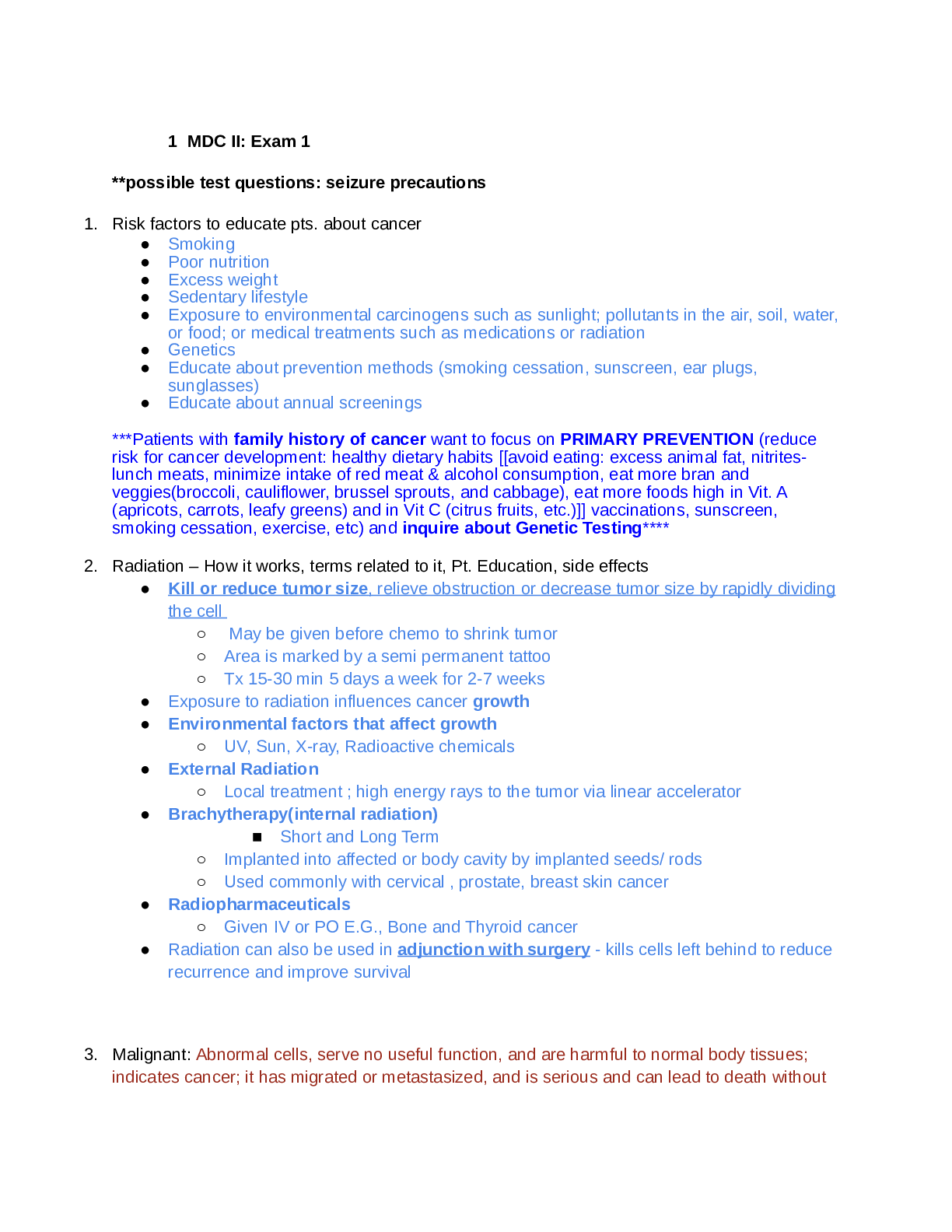
Reviews( 0 )
Recommended For You
Managerial Economics> Solutions Guide > Managerial Economics in a Global Economy 8th Edition By Dominick Salvatore (Solutions Manual ) (All)

Managerial Economics in a Global Economy 8th Edition By Dominick Salvatore (Solutions Manual )
Reflecting the highly globalized nature of tastes, production, labor markets, and financial markets in today's world, Managerial Economics in a Global Economy, Eighth Edition, presents the theory of t...
By eBookSmTb , Uploaded: Jun 01, 2022
$20
Business Administration> Solutions Guide > Australasian Business Statistics 4th Edition By Black, Asafu ,Adjaye, Burke, Khan, King, Perera, Papadimos, Sherwood, Wasimi (Solution Manual All Chapters) (All)

Australasian Business Statistics 4th Edition By Black, Asafu ,Adjaye, Burke, Khan, King, Perera, Papadimos, Sherwood, Wasimi (Solution Manual All Chapters)
Data-driven decisions are driving the global knowledge economy. To get the edge, graduates need the power of statistical analysis to create business insight. This fourth edition of Australasian Busine...
By eBookSmTb , Uploaded: Nov 23, 2021
$20
Business Law> Solutions Guide > International Economics Theory and Policy 12th edition By Paul R. Krugman, Maurice Obstfeld, Marc Melitz (Solutions Manual ) (All)

International Economics Theory and Policy 12th edition By Paul R. Krugman, Maurice Obstfeld, Marc Melitz (Solutions Manual )
1. Introduction PART 1: INTERNATIONAL TRADE THEORY 2. Word Trade: An Overview 3. Labor Productivity and Comparative Advantage: The Ricardian Model 4. Specific Factors and Income Distribution 5....
By eBookSmTb , Uploaded: Nov 05, 2022
$25
Education> Solutions Guide > Essentials of Accounting for Governmental and Not-for-Profit Organizations, 14th Edition By Paul Copley (Solutions Manual ) (All)
.png)
Essentials of Accounting for Governmental and Not-for-Profit Organizations, 14th Edition By Paul Copley (Solutions Manual )
The focus of Copley's Essentials of Accounting for Governmental and Not-for-Profit Organizations, 14th edition is on the preparation of external financial statements which is a challenge for governmen...
By eBookSmTb , Uploaded: Oct 07, 2022
$20
Urban Policy and Planning> Solutions Guide > Dental list Yellow pages (All)
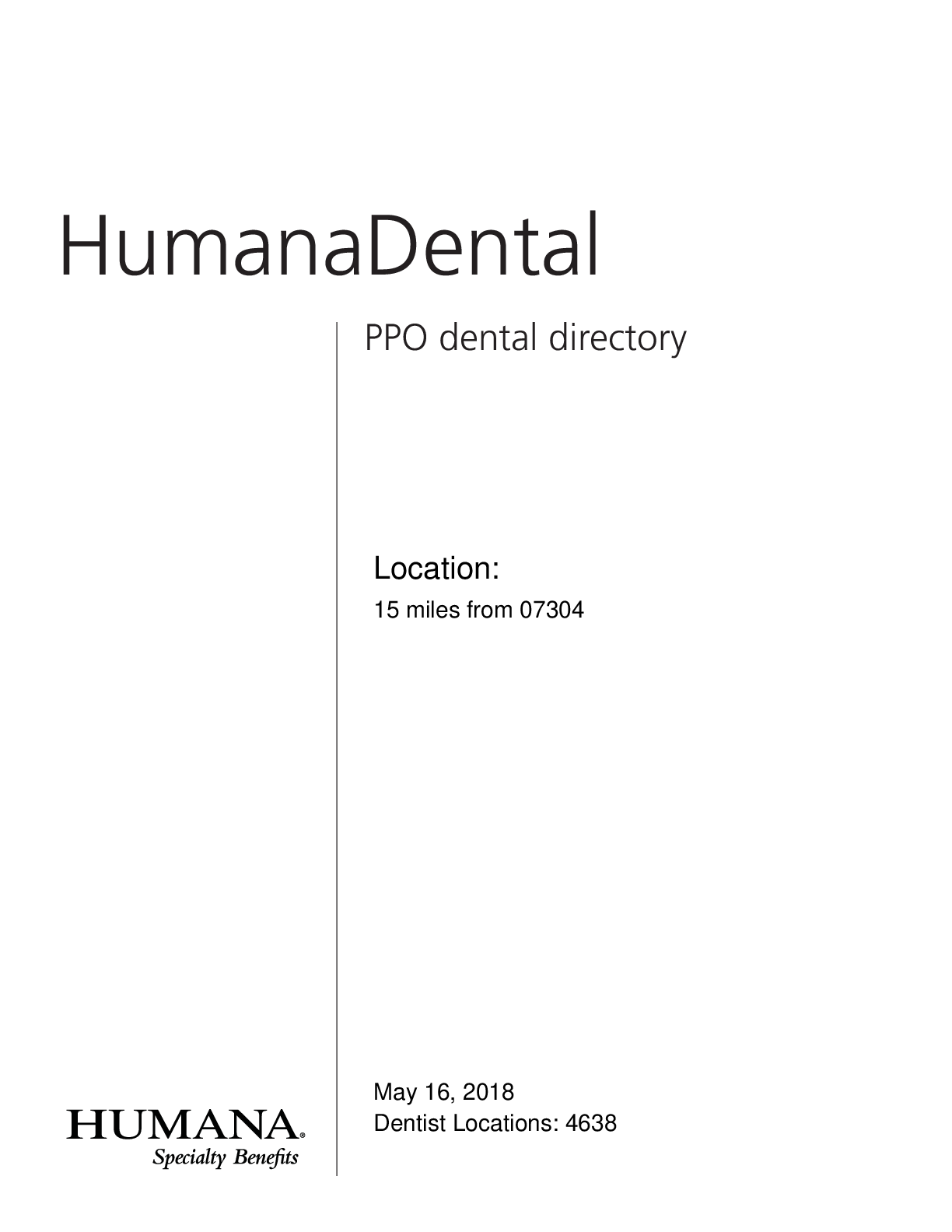
Dental list Yellow pages
HumanaDental PPO dental directory Location: 15 miles from 07304 May 16, 2018 Dentist Locations: 4638 Get the most out of your dental plan. the covered person must send us a letter requesting a...
By Academia1434 , Uploaded: Mar 30, 2021
$1
Statistics> Solutions Guide > MAT 240 Module Five Assignment Hypothesis Testing for Regional Real Estate Company (All)
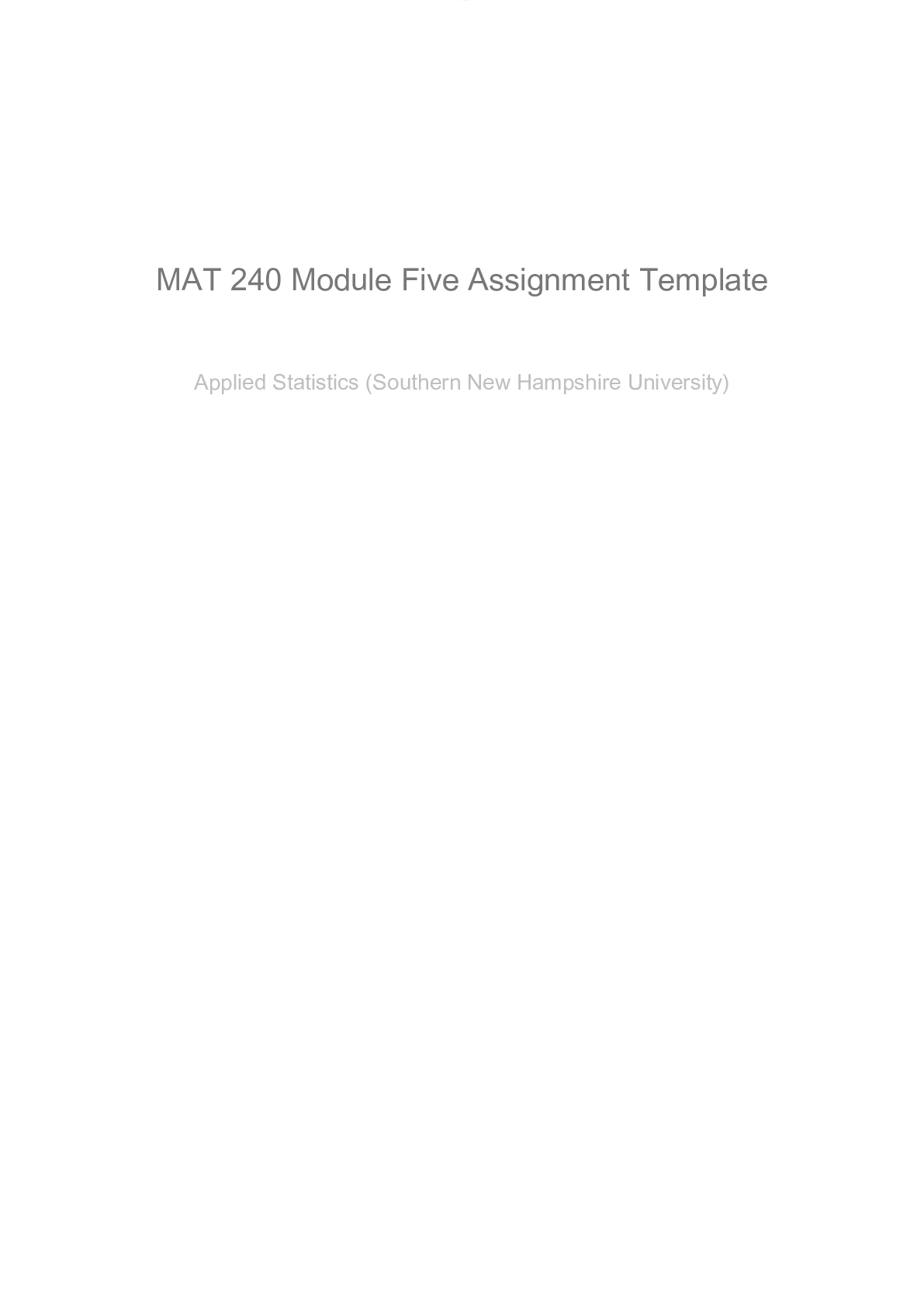
MAT 240 Module Five Assignment Hypothesis Testing for Regional Real Estate Company
Scenario You have been hired by the Regional Real Estate Company to help them analyze real estate data. One of the company’s Pacific region salespeople just returned to the office with a newly desi...
By ACADEMICTUTORIAL , Uploaded: May 26, 2022
$4
Finance> Solutions Guide > Week 4 Mini Case Complete The Chapter 9 (All)
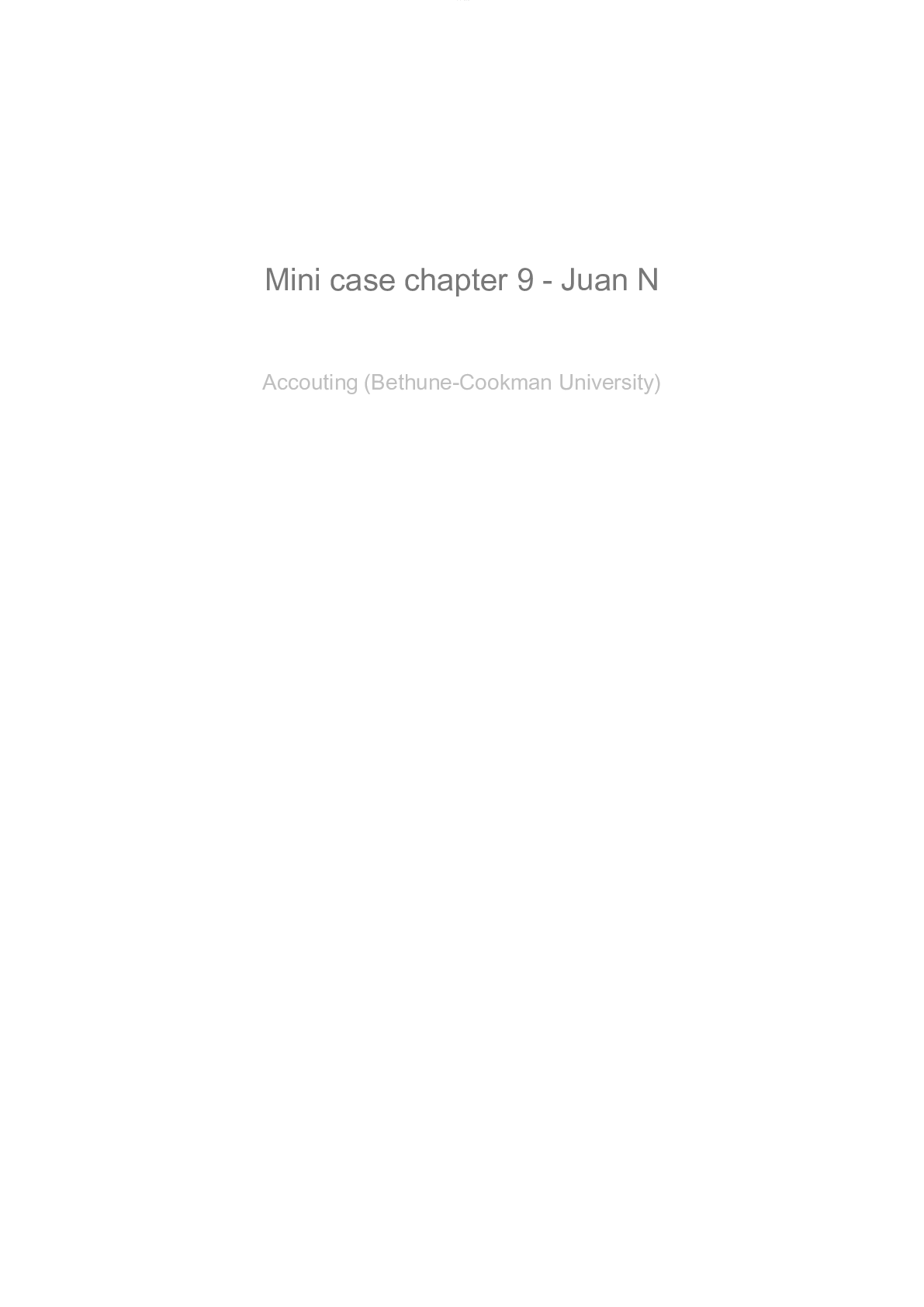
Week 4 Mini Case Complete The Chapter 9
During the last few years, Jana Industries has been too constrained by the high cost of capital to make many capital investments. Recently, though, capital costs have been declining, and the company h...
By ACADEMICTUTORIAL , Uploaded: May 26, 2022
$3.5
Accounting> Solutions Guide > ACCT370 Excel Project Part 3 (All)

ACCT370 Excel Project Part 3
EXCEL PROJECT: PROJECTING FINANCIAL STATEMENTS ASSIGNMENT INSTRUCTIONS OVERVIEW Common Sized Balance Sheets (Tabs 12), Common Sized Income Statements (Tab 13), Horizontal Analysis Balanc...
By ACADEMICTUTORIAL , Uploaded: Feb 14, 2023
$6.5
Business> Solutions Guide > Read the Chapter 19 Mini Case in Financial Management: Theory and Practice (All)
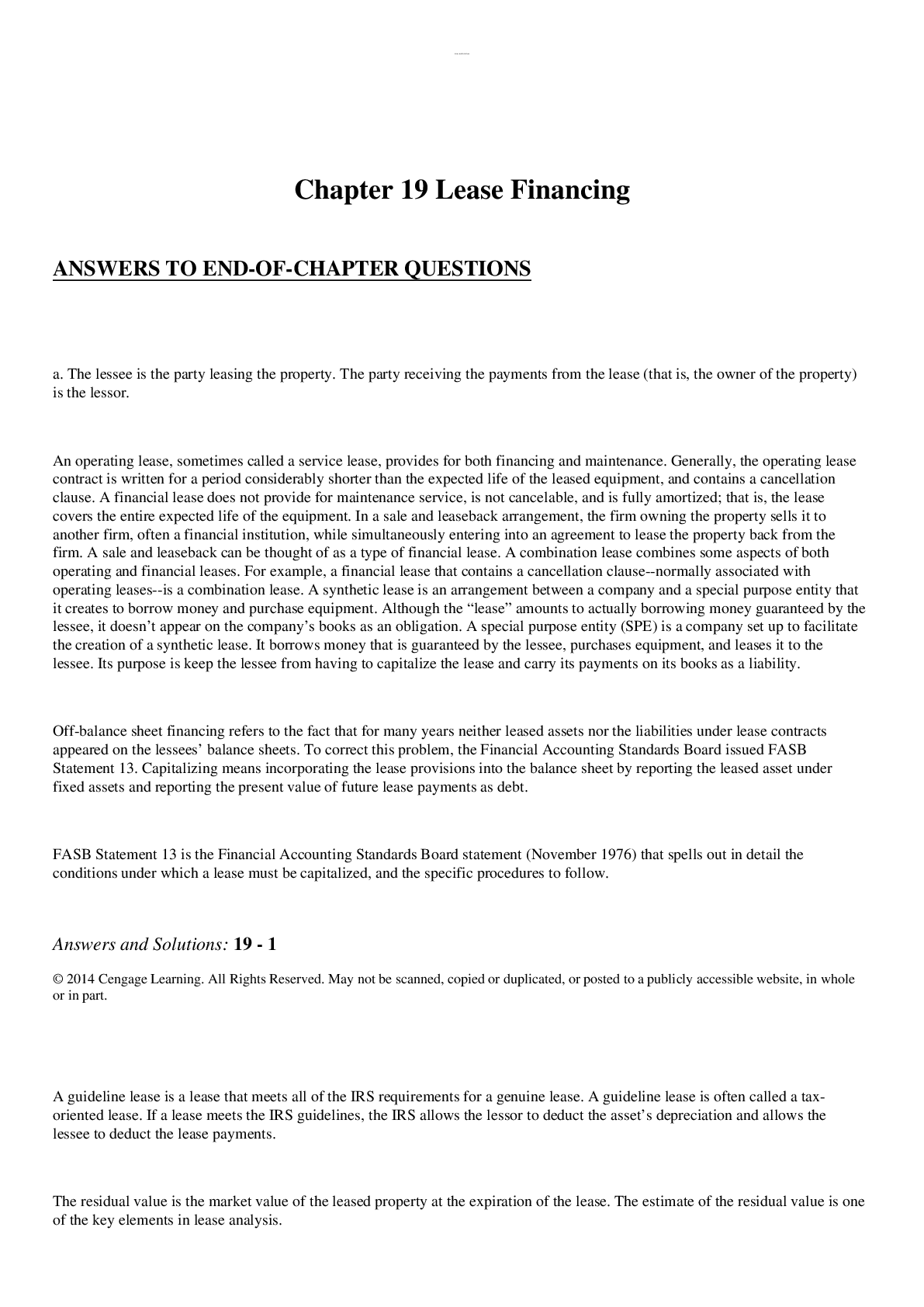
Read the Chapter 19 Mini Case in Financial Management: Theory and Practice
Chapter 18 leasing and financing Chapter 19 Mini Case in Financial Management Lewis Securities Inc Read the Chapter 19 Mini Case in Financial Management: Theory and Practice. Using complete sen...
By ACADEMICTUTORIAL , Uploaded: May 01, 2023
$5.5
Calculus> Solutions Guide > Applied Calculus, 6th Edition By Hughes-Hallett, Lock, Gleason (Solutions Manual) (All)

Applied Calculus, 6th Edition By Hughes-Hallett, Lock, Gleason (Solutions Manual)
A text for interactive Calculus courses, featuring innovative problems This sixth edition of Applied Calculus engages students with well-constructed problems and content to deepen understanding. The R...
By eBookSmTb , Uploaded: Dec 09, 2022
$25
Document information
Connected school, study & course
About the document
Uploaded On
Nov 22, 2022
Number of pages
26
Written in
Additional information
This document has been written for:
Uploaded
Nov 22, 2022
Downloads
0
Views
40






